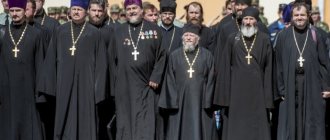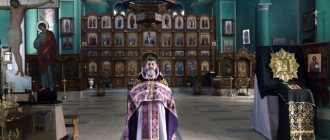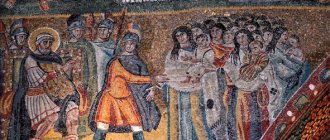The Russian Orthodox Church has published a list of false monks and schismatics who collect money on the Internet or sell utensils allegedly on its behalf. For a small price, parishioners are promised to order a prayer on Mount Athos, in Jerusalem, or to send roses blessed at the saint’s grave. Separately, a list of false monks and schismatics was published, which included the main “obscurantist” of 2022 - ex-schema-hegumen Sergius.
The Russian Orthodox Church has published a list of resources on which false priests, schismatics and scammers collect donations and offer various services allegedly on behalf of the Russian Orthodox Church. Most often, such sites offer to order paid prayer services, magpies, weddings, baptisms, or light a candle in one or more churches for money.
Fraudsters collect funds for the restoration of churches, offer to order a collection of prayers or watch a video broadcast of a service, send a note to Mount Athos or Jerusalem, bless a car or premises, or confess via Skype. This does not include the sale of icons, baptismal sets, candles and other church goods. A prayer for health for a year will cost 68 dollars (a little more than five thousand rubles), and a 20-year prayer on Mount Athos will cost 20 thousand rubles.
The Synodal Department should have long ago compiled a list of such resources to warn parishioners. Many such resources, noted forensic religious expert Igor Ivanishko, have been fleecing gullible citizens for years. But now the Russian Orthodox Church is in a catching-up position. It has long been known that behind many of these resources are people who have nothing to do with the church.
“They collect quite a large amount of money every month. But at the same time, none of the heads of the synodal departments, the ruling bishops, or representatives of the patriarchate made official statements. And this is precisely what created confusion in specific dioceses,” Ivanishko told 360.
Local priests know about some of these resources and warn parishioners not to order services and prayers for them. But previously there was no such information on the websites of the patriarchate and dioceses. The clergy were afraid of accidentally slandering a site. But during the pandemic, services, donations and other church activities went online. There are more scammers, and the Russian Orthodox Church decided to start warning about such sites.
Priests in Russia live on salaries
The first question that, for obvious reasons, concerns those who are interested in the life of priests: what is the situation with salaries? And the answer is clear - it is.
Historically, salary matters are much more complicated for monks. In some religions, they are generally instructed to live only on handouts. For priests and priests, everything turned out much simpler: funding was almost always available, although the sources were different
- Salary from the organization;
- State;
- Parishioners;
- Sponsors;
- Commercial activity.
In Russia, the first option is officially in effect. A priest is a real profession that is in the corresponding register (and this register means a lot, for example, a monk or a sectarian cannot be found there; such professions do not exist).
To save the limited funds of the parish, many priests have to do a variety of jobs themselves. For example, the rector of the Church of the Archangel Michael in the city of Yartsevo, Father Sergius Petrov, himself undertook to restore the road after repairing the temple
An ordinary priest receives a salary according to the contract. Archpriest Andrei (Efanov) talks about how its size is determined:
Andrey (Efanov)
Archpriest
“The parish priest receives a salary, the amount of which is determined by the parish council and depends on the financial situation of the parish. This can be either an amount sufficient to live on or a minimum wage. Some of the clergy serve for free, earning money elsewhere in their free time from serving. But parishioners need to understand that the maintenance of the church and the clergy is their responsibility, no one can feed and support their pastor for them.”
Working day of a temple priest in the Russian Orthodox Church
The working day of the hero of our story begins with the morning service in the temple. It lasts from 8 to about 10 o'clock. Before the service, the clergyman must have time to read the prayer rule. A priest usually serves 3-4 liturgies per week.
After Matins, the clergy perform the so-called services (baptisms, funerals, weddings, prayers). Also, during the day, any parishioner and discuss with him the problems .
At 17-00 the priest begins to perform the evening service , which lasts from 1.5 to 2.5 hours. The hero of our story returns home at 20-21 o'clock.
In addition to serving in the church, performing religious services and talking with parishioners, a priest of the Russian Orthodox Church can be busy with so-called obediences . Obediences are imposed on ordinary priests by the rector of the temple. This could be working with representatives of the media (for example, for former journalists), interaction with medical institutions (for ministers with specialized professional education), teaching in Sunday schools, and similar activities.
The rector of the church, in addition, compiles reports for the local diocese (on work with youth, social, missionary activities), and also searches for sponsors.
The priest of an Orthodox church also has days off (1 or 2 per week). But this is not the usual Saturday and Sunday for everyone. On traditional weekends, clergymen, on the contrary, have a lot of work, since at this time there are the most parishioners in the church.
Priests also have a vacation of 28 calendar days. On vacation, a clergyman, like an ordinary person, gets away from work problems and spends more time with his family. This allows him to regain his mental strength. After all, a priest of the Russian Orthodox Church, just like a doctor and a teacher, communicates a lot with people, faces their problems, and tries to solve them. People in such professions often experience the effects of emotional burnout. Rest helps a person regain peace of mind.
Priests receive different salaries, depending on the situation in the parish
The salary of a priest varies greatly depending on various factors:
- place of parish location;
- church attendance;
- demand for the services of a priest;
- financial situation and financial policy of the diocese.
Yulia Sysoeva, the widow of Daniel’s father, says:
“The rectors of large, rich churches have a good income - about the same as that of a mid-level businessman. That is, it will be enough for a European-quality renovation of an apartment, a good foreign car, a dacha and regular family trips to Turkey. Ordinary priests, including priests of the same rich churches, and rectors of poor churches, have average, if not low, income.”
This situation gives a truly grandiose spread, when the salary of a priest ranges from 20 to 200 thousand rubles.
25000
average salary of a priest
- On average you can count on 25,000;
- In Moscow the figure will be around 60,000;
- In St. Petersburg - 50,000;
- Primorsky Krai - 100,000.
Where do priests get Mercedes?
The image of the “butt in a Mercedes” remains a trend in news and television programs to this day. The topic of the wealth of priests has been greatly exaggerated. Often everything is exaggerated. Let's start with the car. Why does a priest need a car? A priest has many responsibilities and his day is very busy. After the liturgy - performing services, visiting hospitals, funerals, weddings, baptisms, conversations at school, visiting nursing homes, correctional colonies... Nowadays, a priest simply cannot get anywhere without a car. “Not a luxury, but a means of transportation.” When my car broke down, I couldn’t get anywhere. Taking a taxi is quite expensive.
Now about car brands. Some advise priests to travel almost on a scooter or bicycle, or in a car that is thirty or more years old and which takes longer to repair than to drive. This is also wrong. I serve in a fairly poor city (especially before the war). However, among our clergy there is not a single priest driving a Mercedes. I don’t see the kind of priests they show on TV - that someone has a Mercedes, someone has a Gelendvagen, someone wears Gucci or Armani. We don't have those.
A priest is a “slice” of the flock among whom he serves. If his parish has very wealthy parishioners, or he lives in a large, wealthy city where his relatives do business, he can buy himself a more expensive car that won’t break down every month. We have many priests who serve in rural parishes. The parishioners there are poorer. The temple has shabby decoration, and the priest drives a modest car.
There are priests who, having received an expensive business-class car as a gift from sponsors or rich relatives, are proud of it and are not going to change to a more modest car. This causes indignation among people: they do not understand why, without having a corresponding income of their own, he drives such an expensive car. As a rule, such people are random in the Church. There are few of them, they stand out from the rest of the priests, television reporters pay attention to them, each such case is inflated as much as possible and widely covered in the press. I am also categorically against this. It seems to me that the car should be good, reliable, but inexpensive. I would urge such priests to think about the fact that they are confusing people.
For most priests, a car is simply his workhorse. Lanos, Chevrolets, Renaults are the most ordinary and modest cars that do not cause any surprise on the city streets. These are used by doctors, teachers, and factory workers. Look at your priest’s car: as a rule, it is in the middle price segment.
It happens that a person comes to the Svyatogorsk Lavra and sees a lot of expensive cars there. He thinks these are all clergy machines. In fact, very rich guests and deputies of all levels come to the Lavra for major holidays. Their cars are parked at the Lavra.
Many people look at what kind of cars the bishops and the patriarch drive, who are entitled to a business-class car due to their status - in order to be perceived in the highest circles of power, where they have to decide issues important for the Church - and think that all priests are absolutely rich. But that's not true. Go to the Ozeryanovsky Church and see in what conditions the priest serves there, to Nikitovka, to Golma, to Kondratievka, to Bessarabka. Believe me, there is no talk of any Mercedes there. Whoever wants to, come visit me. I live in the most ordinary apartment, I drive the most ordinary car and I don’t have any millions.
Imagine if the patriarch or metropolitan arrives in a Tavria or a Lada to meet with the president. This will only cause laughter and misunderstanding. The Patriarch is the head of the Church. The entire Church is judged by it - whether it is a collection of only some illiterate peasants and poor people, or whether influential, highly erudite and successful people are considered an honor to belong to it.
We have always strived to bring the best to the Church. Look at the lamps in the Church of the Holy Sepulcher, at the decorations of the icon cases of many icons. Previously, the icon cases and lamps of our temples were decorated with precious stones and gold, today they try to cover even cheap metal with gold. It was not allowed for the face of the Church to look poor and wretched. People like Serbian Patriarch Pavel, who rode trolleybuses, are an exception to the rule. Such phenomena are condemned and discussed, tried to be accepted or treated with outright misunderstanding.
Now about clothing and liturgical accessories. Like any quality item, they cost some money. Cassocks, for example, are not cheap. I and many other priests have two. I've been wearing them for several years.
Priests receive additional income from demand, but they should not have set tariffs
A priest's salary is not limited to his salary. Technically, it is not limited by any ceiling and depends on the demand for the priest’s services, his enthusiasm and the generosity of the parishioners.
Requirements are services that a clergyman conducts privately to order. There is an established tradition in the church that people pay certain amounts for these services, often according to tariffs. But it's not right. This approach is alien to Christianity.
You can give thanks financially for the demand, but only as much as the person deems necessary. Tariffs for priest's services are wrong.
Nevertheless, it is what it is: priests often introduce parishioners to prices, turning them into clients. For the Orthodox Church this is a problem and a stain on its reputation, but it is perceived as a necessary measure. After all, in theory, these incomes make up not only the priest’s salary, but also funds for other needs of the parish.
Professional training
In order to become a priest, you need to graduate from a higher educational institution that specializes in training future clergy. This could be, for example, a theological seminary, a theological academy or an Orthodox university.
The duration of study in this area is five years, where students study theology, the foundations of faith, the history of the Bible, sect studies, pastoral pedagogy, etc.
Psychology is the main and dominant subject of study for future priests. Upon completion of training, graduates must undergo practical service in one of the churches, where they will be assigned a mentor-priest. It is the mentor’s word that will be decisive when certifying a graduate and assigning him the status of a priest.
Trade in the church is condemned by the Sixth Ecumenical Council, but locally it is practiced everywhere
Rule 76 of the Sixth Ecumenical Council also prohibits trade in the temple and on its territory:
“No one should make purchases inside the sacred enclosures, while maintaining reverence for the churches. For our Savior and God, teaching us through His life in the flesh, commanded us not to make His Father’s house a house of purchase. He scattered money to the money changers, and drove out those who created the holy temple into a worldly place (John 2:15-16). Therefore, if anyone is convicted of the crime mentioned above, let him be excommunicated.”
But we have traded and continue to trade. The typical excuse here is: “If you allow candles to be taken for donations, then no one will donate a penny.” The fears are fair, but it still doesn’t happen once in a while. Those priests who allow themselves such statements speak too negatively about the parishioners. If there is a miser, there will also be a generous person.
Profits from the distribution of candles and literature in the church go towards the needs of the parish, including the priest’s salary.
In addition, we have the example of the Greek Orthodox Church, where candles are given out free of charge. But the situation there is different: the church is under the protection of the state, and therefore financial problems are not so terrible for it. In Russia, the church is also constantly rushing into politics, but here it is fair to separate the situation at the top and the problems of a village parish abandoned by everyone.
It is clear that in the Cathedral of Christ the Savior, financial problems are nonsense.
Under favorable circumstances, a priest can increase his salary through the commercial activities of the parish, but these are all hypothetical possibilities.
The parish earns money from donations and personal initiatives
The parish has several ways to replenish its capital:
Donations . These are voluntary contributions that parishioners make for no reason or for certain services and goods (requirements, candles, books, icons).
Trade . It has already been discussed above: it is condemned, but it is one of the main sources of income for the church.
Fees . Sometimes, usually on holidays, the priest may announce that the parish needs money for certain needs. It never happens that among the people there are not those who will give one hundred or five hundred rubles.
Sponsors . It happens that there are rich people or organizations who simply agree to help the church financially. It’s not always finance; sometimes it’s construction materials or something else. But this is a fairly common practice. When a person is rich enough to painlessly part with a significant amount of income, such situations no-no do happen.
Sometimes the priest himself can announce to parishioners that the parish is in need of finances
Personalized bricks . This is when the names of those who made some donation for the repair or construction of the temple are written on the bricks. This practice is usually found during the construction of a building. People want to become involved in the creation of the shrine. During renovation work, people's interest is no longer so great.
Entrepreneurship outside the church . The church has the legal right to conduct commercial activities, but only for its own needs: repairs, restoration, charity. For example, one priest sold milk and earned more than from candles. The income is taxed, but still it is something.
Saving . In many ways, the parishioners help the priest. If there are people with initiative, with head and hands, then they are able to provide repairs and get a discount where necessary.
How much does the Russian Orthodox Church earn?
The Russian Orthodox Church (ROC) is an extensive corporation, rich and influential. Its real income, as well as the items on which expenses are incurred, are not known to the general public and even interested parties.
Based on indirect evidence, we can conclude that they amount to trillions of rubles. This follows from the fact that the non-taxable income of the church (ceremonies and rituals, donations, proceeds from the sale of religious literature), according to publicly available data from two years ago, amounted to 5.6 billion rubles.
The church in the Russian Federation is separated from the state, but it receives financial support from the state for cultural programs, projects related to the restoration of historical monuments, the functioning of diocesan hospitals and the creation of charitable foundations.
Priests live in their own houses; they are not given housing
Priests are not given living space. And this is a big problem for those who would like to leave an inheritance to relatives or children. Since after theological school they can be sent to any corner of the country, priests live in special church houses.
If you leave, the house goes to a new priest.
If you want something of your own, you have to earn it. And here everything depends on the circumstances of the priest’s life: how much he receives, how clean his hands are, what the mentality of the parish is, etc.
This is how priests in Russia live after college: without a home and without confidence in the future.
Church profits go towards utilities, salaries and various promotions.
We figured out how the church makes money. How does he spend it? The list here is impressive.
It’s good if as much as the parish receives, it spends as much. And if you manage to put it off, it’s perfect.
- Clergy salary;
- Correspondence;
- Communal payments;
- Repair;
- Petrol;
- Church equipment;
- Sunday Schools;
- Charity.
And much more. The same Eucharistic bread needs to be baked for something, but the church has a common capital for everything.
A theological seminary graduate can become a priest
Those who have considered becoming a priest may have been put off by the challenges listed above. If so, it's for the best. You must either be prepared for difficulties or not take them on at all, so as not to be disappointed.
To become a priest, you need to go through a rather difficult path. The most difficult stage is completing theological seminary. The problem here is that people just don’t get into it. There are requirements:
- Sincere faith . How to prove that you believe or do not believe? Arguments will not help here. You just need to make the right impression at the admissions interviews.
To become a priest, you need to have excellent knowledge of Orthodoxy.
- Church service experience . People are admitted to the seminary upon a corresponding request from the parish priest. And you can receive this document only if you prove yourself well by helping in the parish. There are difficulties here. If you run into a harmful priest, he may, for some reason of his own, delay the procedure.
- Sufficient knowledge of the Church Slavonic language, Holy Scripture and prayers . Each seminary has its own level of sufficiency. But usually the requirements are quite strict in order to accept only worthy candidates for study.
Students of Sretensky Theological Seminary are future priests.
The benefits begin after a person is accepted for study. The main good news is that you don’t have to pay for your studies. Every day you will encounter new knowledge, and then there is a chance to continue your studies and get an education, for example, as a theologian.
If the path of a priest is preferable, then it is worth considering that, according to distribution, they can be sent to a distant village, thousands of kilometers from family and friends.
All these difficulties show that priests in Russia live differently. Someone was lucky to find a job in an excellent parish, perhaps even close to home. And someone is huddled in a church house, counting pennies.
By leaving a comment, you accept the user agreement
Roses from a gravestone
But there are also unusual services. One of the resources sells rose petals allegedly consecrated on the tombstone of St. Xenia of St. Petersburg. A bud with a small laminated icon will cost gullible people 80 rubles, a bottle of blessed oil - 100 rubles. The most expensive item is a folding triptych icon for 300 rubles.
On another they offer to print out a note and supposedly stand in the usually huge line to see the relics of the Matrona of Moscow. And then provide the sufferers with a photo report. The prices are quite humane - sending a note costs 360 rubles, a rose - 350 rubles. However, it is not clear whether this amount includes the cost of the bouquet. And for just 50 rubles you can buy a candle. Apparently, from the Intercession Monastery on Taganka itself.
A list of former clergy who are prohibited from holding services and engaging in church activities has been published separately. This includes the notorious ex-schema-hegumen Sergius (Nikolai Romanov), who was suspected of torturing children, extorting money, spreading fake news about the coronavirus, and so on. When you read reports about his seizure of the monastery, the run during the religious procession, the attack on the film crew of Ksenia Sobchak, and so on, the thought involuntarily arises that anathema alone is not enough for punishment.










